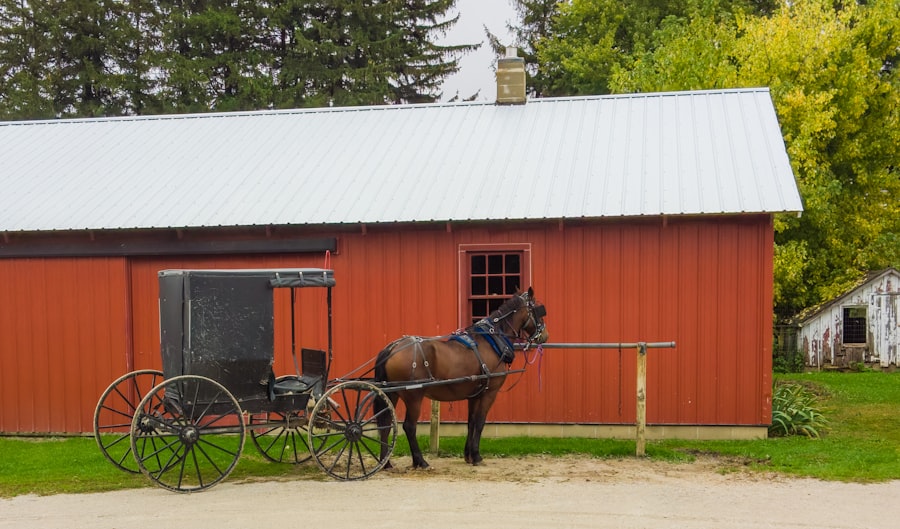Keeping chickens and bees together has become increasingly popular among homesteaders and small-scale farmers in recent years. This integrated approach to livestock and apiculture offers several benefits, including enhanced pollination, natural pest control, and sustainable food production. By combining chickens and bees, farmers can create a more diverse and resilient agricultural ecosystem that promotes the health and productivity of both animals and plants.
However, this integration also presents important considerations and potential challenges. This article examines the advantages, key factors to consider, and best practices for maintaining chickens and bees in close proximity. Additionally, it addresses potential obstacles and provides solutions for effectively managing this integrated system.
Table of Contents
- 1 Benefits of Keeping Chickens and Bees Together
- 2 Considerations for Keeping Chickens and Bees Together
- 3 Creating a Suitable Environment for Chickens and Bees
- 4 Managing the Interaction Between Chickens and Bees
- 5 Potential Challenges and Solutions for Keeping Chickens and Bees Together
- 6 Conclusion and Final Tips for Keeping Chickens and Bees Together
- 7 FAQs
- 7.1 What are the benefits of keeping chickens and bees together?
- 7.2 Are there any risks or challenges in keeping chickens and bees together?
- 7.3 What precautions should be taken when keeping chickens and bees together?
- 7.4 Can chickens and bees coexist in the same area without issues?
- 7.5 What are some tips for successfully keeping chickens and bees together?
Key Takeaways
- Keeping chickens and bees together can be a mutually beneficial practice for both animals and the environment.
- Benefits of keeping chickens and bees together include increased pollination, pest control, and the production of honey and eggs.
- Considerations for keeping chickens and bees together include providing adequate space, ensuring the safety of both animals, and managing potential conflicts.
- Creating a suitable environment for chickens and bees involves providing access to natural forage, clean water, and suitable shelter.
- Managing the interaction between chickens and bees requires careful observation, proper introduction, and monitoring for any signs of stress or aggression.
Benefits of Keeping Chickens and Bees Together
Improved Pest Control and Pollination
Chickens can benefit from the presence of bees by consuming pests such as wax moths, small hive beetles, and other insects that can harm beehives. In turn, bees can benefit from the presence of chickens by increasing pollination rates through their foraging activities. This can lead to improved crop yields and a more diverse and abundant food supply for both the chickens and the bees.
Enhanced Ecosystem Balance and Resilience
The presence of chickens can help deter predators such as skunks and raccoons that may pose a threat to beehives. By integrating chickens and bees, farmers can create a more balanced and resilient ecosystem that supports the health and productivity of both animals.
Increased Sustainability and Self-Sufficiency
Another benefit of keeping chickens and bees together is the potential for increased sustainability and self-sufficiency on the farm. Chickens can provide valuable sources of protein through their eggs and meat, while bees can contribute to the production of honey, beeswax, and other hive products. By combining these two sources of food and income, farmers can create a more diverse and resilient agricultural system that is less reliant on external inputs.
Improved Soil Fertility and Long-Term Sustainability
The integration of chickens and bees can also help improve soil fertility through the deposition of chicken manure and the pollination activities of bees. This can lead to healthier and more productive gardens, orchards, and pastures, ultimately supporting the long-term sustainability of the farm.
Considerations for Keeping Chickens and Bees Together

While there are many benefits to keeping chickens and bees together, there are also important considerations to keep in mind when integrating these two species. One key consideration is the potential for conflict between chickens and bees. Chickens may be attracted to beehives due to the presence of honey and other hive products, which can lead to disturbances at the hive and potential harm to the bees.
Additionally, bees may become agitated by the presence of chickens near their hives, which can lead to defensive behavior such as stinging. To mitigate these potential conflicts, it is important to carefully manage the interaction between chickens and bees and create a suitable environment that supports the needs of both species. Another consideration for keeping chickens and bees together is the potential for disease transmission between the two species.
Chickens can be carriers of certain diseases that may be harmful to bees, such as foulbrood or nosema. Similarly, bees can transmit diseases such as American foulbrood to chickens through contaminated honey or hive products. To minimize the risk of disease transmission, it is important to maintain good hygiene practices and regularly monitor the health of both the chickens and the bees.
This may include implementing biosecurity measures, such as keeping beehives at a safe distance from chicken coops and regularly cleaning and disinfecting equipment used for both chickens and bees.
Creating a Suitable Environment for Chickens and Bees
Creating a suitable environment for both chickens and bees is essential for successfully integrating these two species on the farm. When it comes to housing, it is important to provide separate and secure accommodations for both chickens and bees. For chickens, this may include a well-ventilated coop with nesting boxes, roosts, and access to outdoor space for foraging.
For bees, this may include well-maintained hives with adequate space for foraging, as well as protection from predators and extreme weather conditions. By providing separate housing for chickens and bees, farmers can minimize potential conflicts and disturbances between the two species. In addition to separate housing, it is important to carefully manage the placement of beehives in relation to chicken coops.
Bees should be situated in an area that is easily accessible for foraging but also at a safe distance from chicken coops to minimize disturbances from the chickens. It is also important to provide adequate forage for both chickens and bees, including diverse plantings that support pollinators and provide nutritious forage for chickens. By creating a diverse and abundant environment that meets the needs of both species, farmers can support the health and productivity of their chickens and bees while minimizing potential conflicts.
Managing the Interaction Between Chickens and Bees
Managing the interaction between chickens and bees is essential for maintaining a harmonious relationship between these two species. One way to manage this interaction is through careful observation and monitoring of both chickens and bees. By regularly observing the behavior of both species, farmers can identify any potential conflicts or disturbances and take proactive measures to address them.
This may include adjusting the placement of beehives or chicken coops, providing additional barriers or protections around beehives, or implementing changes to feeding or foraging routines for the chickens. Another way to manage the interaction between chickens and bees is through strategic timing of activities on the farm. For example, farmers may choose to conduct certain management activities such as hive inspections or chicken feeding during times when bee activity is minimal, such as early in the morning or late in the evening.
By coordinating activities in this way, farmers can minimize disturbances to both chickens and bees while ensuring that their needs are met. Additionally, providing ample space for both chickens and bees to forage and roam can help to reduce competition between the two species and support their natural behaviors.
Potential Challenges and Solutions for Keeping Chickens and Bees Together

Predation and Safety Concerns
One common challenge is the potential for predation on beehives by chickens or other wildlife. To address this challenge, farmers can implement measures such as installing predator-proof fencing around beehives or using electric fencing to deter predators. Additionally, providing secure housing for both chickens and bees can help to minimize the risk of predation and ensure the safety of both species.
Pest and Disease Management
Another potential challenge is the management of pests and diseases that may affect both chickens and bees. For example, mites such as Varroa destructor can pose a threat to bee colonies, while parasites such as lice or mites may affect chicken health.
Integrated Pest Management Strategies
To address these challenges, farmers can implement integrated pest management strategies that focus on prevention, monitoring, and targeted treatments for pests and diseases. This may include regular inspections of beehives for signs of pest infestations, as well as implementing biosecurity measures such as quarantining new poultry additions to prevent the spread of diseases.
Conclusion and Final Tips for Keeping Chickens and Bees Together
In conclusion, keeping chickens and bees together offers a range of benefits for small-scale farmers and homesteaders, including increased pollination, pest control, sustainability, and self-sufficiency. However, there are important considerations to keep in mind when integrating these two species, including managing potential conflicts, disease transmission, creating a suitable environment, managing interactions, and addressing potential challenges such as predation or pest management. By carefully considering these factors and implementing best practices for managing the interaction between chickens and bees, farmers can create a more diverse and resilient agricultural system that supports the health and productivity of both animals.
Some final tips for keeping chickens and bees together include providing ample space for both species to forage and roam, maintaining good hygiene practices to minimize disease transmission, carefully managing the placement of beehives in relation to chicken coops, implementing integrated pest management strategies, regularly monitoring the health of both chickens and bees, providing diverse plantings that support pollinators and provide nutritious forage for chickens, providing secure housing for both chickens and bees, coordinating activities on the farm to minimize disturbances between chickens and bees, implementing biosecurity measures such as quarantining new poultry additions, installing predator-proof fencing around beehives or using electric fencing to deter predators. By following these tips and best practices, farmers can successfully integrate chickens and bees on their farms while maximizing the benefits of this integrated system.
If you’re considering keeping chickens and bees together, you may also be interested in learning about different types of chicken coops. Check out this article on SnapLock Chicken Coop for information on a convenient and secure housing option for your feathered friends.
FAQs
What are the benefits of keeping chickens and bees together?
Keeping chickens and bees together can provide several benefits. Chickens can help control pests in the beekeeping area, such as small insects and larvae, while bees can help pollinate plants and increase the yield of the chickens’ foraging area.
Are there any risks or challenges in keeping chickens and bees together?
One potential risk is that chickens may disturb beehives and agitate the bees, leading to stinging incidents. Additionally, chickens may consume bees or their honey, which can be detrimental to the bee colony. Proper management and planning are essential to minimize these risks.
What precautions should be taken when keeping chickens and bees together?
It is important to provide adequate space and separation between the chicken coop and the beehives to minimize disturbances. Additionally, ensuring that the chickens have access to a balanced diet and are not solely reliant on the bees for food can help prevent them from consuming bees or honey.
Can chickens and bees coexist in the same area without issues?
With proper management and precautions, chickens and bees can coexist in the same area without significant issues. However, it is important to monitor their interactions and make adjustments as needed to ensure the well-being of both the chickens and the bees.
What are some tips for successfully keeping chickens and bees together?
Providing ample space, proper nutrition for the chickens, and ensuring that the beehives are secure and not easily accessible to the chickens are important tips for successfully keeping chickens and bees together. Regular observation and proactive management can also help prevent potential conflicts.
Meet Walter, the feathered-friend fanatic of Florida! Nestled in the sunshine state, Walter struts through life with his feathered companions, clucking his way to happiness. With a coop that’s fancier than a five-star hotel, he’s the Don Juan of the chicken world. When he’s not teaching his hens to do the cha-cha, you’ll find him in a heated debate with his prized rooster, Sir Clucks-a-Lot. Walter’s poultry passion is no yolk; he’s the sunny-side-up guy you never knew you needed in your flock of friends!







